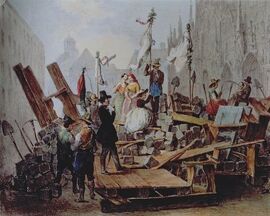By the time of the Danubian Revolution, Habsburg power had become regarded as an almost permanent fixture of European life. They had controlled the Holy Roman Empire since the middle of the 15th century and reigned over, at their peak, from Balboa in the West to Lviv in the East and from Amsterdam in the North to Syracuse in the South. Equally, however, the house of Habsburg had been on a seemingly inexorable decline, having lost all of her territories outside of Central Europe, and with her domination of Germany under severe pressure by the Prussians in the North.

The dominions of the House of Habsburg at its greatest extent at the abdication of Charles V
1848 was a year of revolution across Europe as liberals rose up against the old order. Only the previous year, Jacobin rebels had taken arms against the King of Prussia after peaceful protests were violently suppressed on the streets of Berlin. The loss of Königsberg to the Russians, compounded by a failure to make gains in the West, meant that the Franco-Prussian war had been a disaster for the country despite all of the money invested by the military. The resulting debts forced the Kaiser to institute broad tax increases for all, most notably the growing middle-class and industrialists; resentment grow into apathy and apathy into civil war.
It was not until March of 1848 that issues began to arise in the Austrian provinces. Sándor Petőfi’s poem Nemzeti dal ("National Song") inspired riots in Budapest and a declaration of Hungarian Independence. The refrain of “By the God of the Hungarians/We vow,/We vow, that we will be slaves/No longer!” was chanted as the growing mob released massed ranks of political prisoners and seized printing presses. By June, Emperor Ferdinand I had been forced to mobilise the rest of the country in an attempt to suppress the Hungarians, who by this time had established a working parliament and had de facto control of all Austrian territory encompassed in modern Hungary and Slovakia plus large areas to the East. There was even talk in the corridors of the Hofburg palace of invoking the “Holy” alliance with Russia.

Sándor Petőfi reciting the Nemzeti dal to the crowd on 15th March 1848.
This, however, was not to be, as the increasingly paranoid Ferdinand imposed ever more draconian laws on his subjects. The final piece of legislation ever enacted by a Habsburg Emperor, and against the advice of Prince Metternich, banned public meeting areas, including the famous Viennese Coffee Houses. Unsurprisingly, the formal announcement so quickly spread mass hysteria that within just a week almost every town in German Austria had had riots of one sort or another.
By far the most troubled city was Vienna herself, where the mob grew ever more restless with Imperial intransigence. On 27th July 1848, Prince Metternich defected against a leader he saw as “irredeemably intent on suicide” and gave such a speech in front of Vienna’s St Stephen’s Cathedral that the capital’s citizens finally took up arms and marched on the Hofburg. In the ensuing battle saw much of the city burned to the ground and the death of around 1/10th of the city’s population, but, with the Royalists defeated and fleeing the city, Metternich declared Austria a republic.

A barricade outside St Stephen’s Cathederal during the Battle for Vienna.
August saw gains for the Republican forces in Austria, who managed to rout all Royalist forces in Italy with final victory coming in the West at the Battle of the Plains of Padua on 4th September. Hungarian forces, meanwhile, suffered a string of defeats to Ferdinand, at Pecs and Kapsovar in the South and Zilina and Trencin in the North. Increasingly afraid of defeat, the Hungarian parliament sent a delegation to Vienna to propose an equal alliance against the Royalist forces. The reply, which was received on 10th September 1848, enclosed a constitution, dubbed by one Hungarian Parliamentarian at the time as a “Federation of Equals”. A further defeat at Gyor, a town a little over 50 miles from Budapest, the following day meant that the Hungarian Parliament approved the deal unanimously.
The Federation arguably saved the Hungarian rebels, with a Danubian forces, mostly made up of Republican Austrians, retaking Bratislava on 16th September. The Federation continued to gain victories over Royalist forces, eventually capturing Ferdinand in Prague in early October. His execution in front of the Hofburg, which had been converted into the new parliament building for the Federation, ended Royalist resistance, with most accepting of the status quo in the absence of an heir.

The state funeral held for all Republicans who fell during the Danubian Revolution, 11th November 1848
Useful notes on prior divergences[]
In 1840, the war of Sardinian Aggression against Switzerland concluded in the submission of the Kingdom of Sardinia and the Grand Duchy of Tuscany to the Austrian crown. Despite the chaos of the 1848 revolution, the two states maintained the treaties that bound them to the Federation and remain its vassals.
A later war against Spain also resulted in the liberation of Cuba under an Austrian-friendly government, though distance has made relations difficult.
| ||||||||||||||||||||
